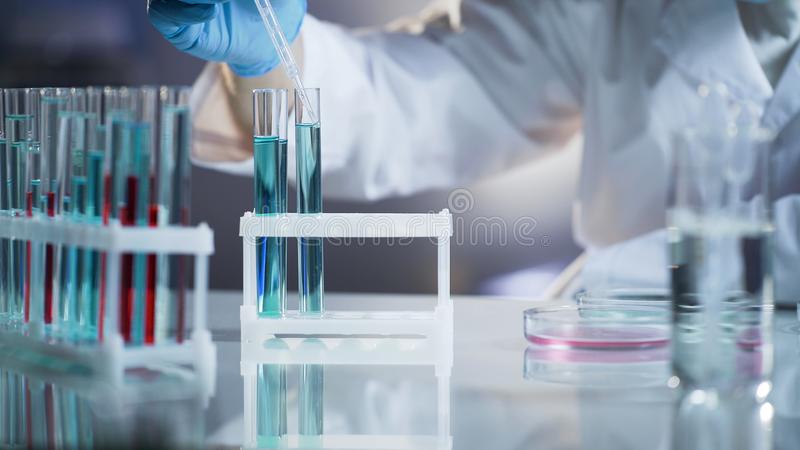Description:
In 1865 Professor N.N. Beketov was the first to put forward a hypothesis about the quantitative relationship between the masses of the reactants and the reaction time: “… the attraction is proportional to the product of the acting masses.” This hypothesis was confirmed in the law of mass action, which was established in 1867 by two Norwegian chemists K. Guldberg and P. Vaage. The modern formulation of the law of mass action is as follows:
Law of mass action states that for a chemical reaction, the rate of reaction is directly proportional to the product of concentration of the reactants.
OR
At a constant temperature, the rate of a chemical reaction is directly proportional to the product of the concentrations of the reactants taken in powers equal to the stoichiometric coefficients in the reaction equation.
For the reaction
aA + bB → mM + nN
the mathematical expression for the law of mass action is:
v = k · C A a · C B b ,
where v is the reaction rate; k – coefficient of proportionality, called the rate constant of a chemical reaction (at C A = C B = 1 mol / l k is numerically equal to v); C A and C B – concentrations of reagents A and B; a and b are stoichiometric coefficients in the reaction equation.
What is rate constant?
The specific rate constant (k) or rate constant is defined as the proportionality factor relating to the rate of a chemical reaction to the concentration of reactants.
The rate constant of a chemical reaction k is determined by the nature of the reacting substances and depends on the temperature, on the presence of a catalyst, but does not depend on the concentration of the substances participating in the reaction.
What is equilibrium constant?
Equilibrium constant (Kc) can be defined as the ratio of concentration of products to the concentration of reactants. It also defined as the ratio of rate constant of forward reaction to the rate constant of reverse reaction of a chemical reaction.
At equilibrium,
Kc = [products]/[reactants]
Kc = Kf/Kr
Kequ = kf/kc = [C]c [D]d/[A]a [B]b = Kc
Factors affecting Kc
- Change in concentration of reactants or products
- Change in pressure
- Change in temperature
- Catalyst
- Inert gas
Expression of the equilibrium constant
The expression of the equilibrium constant is established according to the equation of the chemical reaction concerned. Each chemical reaction being different, the expression of each equilibrium constant will be too. However, we can generalize the mathematical expression of the equilibrium constant established as a function of the concentrations as follows:
Let the general equation
aA + bB ⇌ cC + dD
Kc = [C]c ⋅ [D]d ÷ [A]a ⋅ [B]b
Where
- Kc represents the equilibrium constant as a function of the concentrations
- [C] and [D] represent the molar concentrations of the products (mol / L)
- [A] and [B] represent molar concentrations of reactants (mol / L)
- exponents (lowercase letters) refer to coefficients in the balanced chemical equation
The numerical value of Kc tells us about the quantities in moles present at equilibrium. However, in the case where a reaction only involves substances in a gaseous phase, the equilibrium constant can also be calculated from the partial pressures of the different substances:
Let the general equation
aA + bB ⇌ cC + dD
Kp =[PpC]c ⋅[PpD]d ÷ [PpA]a ⋅ [PpB]b
where
- Kp represents the equilibrium constant as a function of partial pressures
- [PpC] and [PpD] represent the partial pressures of the products (kPa)
- [PpA] and [PpB] represent partial pressures of reactants (kPa)
- exponents (lowercase letters) refer to coefficients in the balanced chemical equation
The equilibrium constant is established for the direction of the reaction which is considered. Thus, it will not be the same for the forward reaction as for the reverse reaction. Indeed, since the products and the reagents are not the same substances any more, the numerators and denominators of the expression of the constant will be reversed. Thus, to know the value of the equilibrium constant of the reverse reaction, it suffices to calculate the mathematical inverse of the equilibrium constant of the direct reaction:
KC inv = 1 KC dir
Where KC inv represents the equilibrium constant of the reverse reaction KC dir represents the equilibrium constant of the direct reaction
The interpretation of the equilibrium constant
The value of the equilibrium constant makes it possible to predict the direction in which the equilibrium will be established. Since this is a relationship between the concentration of the products in the numerator and those of the reactants in the denominator, one can determine which direction of the reaction will be favored.
If the equilibrium constant is greater than 1, the numerator is greater than the denominator. Thus, this indicates a greater concentration of products compared to reactants. It can therefore be established that the reaction favoring the products, namely the direct reaction, is preferred. Conversely, if the equilibrium constant is less than 1, the denominator of the ratio is greater than the numerator. It is then the reactants which are dominant with respect to the products and it can be established that the reverse reaction is then favored. Finally, if the constant is roughly equal to 1, the system does not favor one direction of reaction at the expense of the other.
Important!
A value of Kc >1
means that we will find a greater concentration of products than reagents. The direct reaction will be favored .
A value of Kc <1
represents a concentration of reactants greater than that of the products. The reverse reaction will be favored .
A value of Kc ≅ 1
means that there are as many reagents as there are products. No reaction is favored.
Relationship B/W Kc and Kp
Kp =Kc(RT)△n
In this relation,
Kp = equilibrium constant for partial pressure
Kc = equilibrium constant
R = General gas constant
T= Standard temperature
△n = No. of moles of products_ No. of moles of reactants
- number of moles of reagents must be in gaseous state
The effect of temperature on the equilibrium constant
According to Le Chatelier principle, a change in the concentrations or in the pressures of the various substances temporarily disturbs the equilibrium. However, since the equilibrium constant relates the concentrations or pressures to equilibrium, this relationship is always found to be constant. Thus, changes in concentration, pressure or volume have no influence on the value of the equilibrium constant.
Only temperature can modify the value of the equilibrium constant Kc of a given reaction. According to Le Chatelier principle, an increase in temperature has the effect of promoting the endothermic reaction while a decrease in temperature promotes the exothermic reaction. The new equilibrium which is established then does so in proportions different from those of the initial equilibrium. Thus, this new ratio of the concentrations modifies the value of the equilibrium constant of the system. This is the reason why it is always necessary to specify the temperature at which a system is located when giving its equilibrium constant.
Applications of Law of Mass Action
Despite its enormous usefulness, when this law was proposed it did not have the desired impact or relevance in the scientific community.
However, from the twentieth century, notoriety increased thanks to British scientists William Esson and Vernon Harcourt taking it up several decades after its promulgation.
The Law of Mass Action has had many applications over time, which is why some are shown below:
- To be formulated in terms of activities rather than concentrations, it is useful to determine deviations from the ideal behavior of reactants in a solution, provided it conforms to thermodynamics.
- As a reaction approaches equilibrium state, the relationship between the net reaction rate and the instantaneous Gibbs free energy of a reaction can be predicted.
- When combined with the detailed equilibrium principle in general this law provides the resulting values, according to the thermodynamics of the activities and the constant in the equilibrium state, and the relationship between them and the resulting rate constants. reactions in the direct as well as in the opposite direction.
- When the reactions are of the elementary type, by applying this law, we obtain the appropriate equilibrium equation for a given chemical reaction and the expression of its speed.
When the irreversible type reaction between ions is in solution, the general expression of this law leads to the formulation of Bronsted-Bjerrum, which establishes the relationship between the ionic strength of the species and the rate constant is studied.
- By analyzing the reactions carried out in dilute ideal solutions or in a state of gas aggregation, we obtain the general expression of the original law (decade of the 1980s).
- As universal characteristics, the general expression of this law can be used within the framework of kinetics instead of seeing it as part of thermodynamics.
- Is used in electronics, this law is used to determine the multiplication between the densities of holes and electrons of a given surface at a constant amplitude in the state of equilibrium, even independently of the doping to be supplied to the matter .
- It is widely known to use this law to describe the dynamics between predators and their prey, assuming that the relationship of predation to prey exhibits some proportion of the relationship between predators and prey.
- In the field of health studies, this law can even be applied to describe certain factors of human behavior, from a political and social point of view.
The law of mass action is also important in the physics of semiconductors. Regardless of doping, the product of the electron and the hole density is constant at equilibrium. This constant depends on the thermal energy of the system (ie. From E. product Boltzmann constant, and temperature ), as well as the band gap (the energy separation between the conduction band and the valence band ) and the effective density of states in the valence and conduction band.
Yakov Frenkel presented the propagation process in condensed matter as an ensemble of elementary hops and quasi-chemical interactions of particles and defects. Henry Eyring applied his theory of absolute reaction rate to this quasi-chemical representation of diffusion. The mass law for diffusion leads to different nonlinear versions of Fick’s Law.
Limitations
The law of mass action assumes that all chemical reactions are elementary; in other words, the molecularity is the same as the respective reaction order for each species involved.
Here, the stoichiometric coefficients a, b, c and d are considered as the number of molecules involved in the reaction mechanism. However, in an overall reaction, these do not necessarily coincide with their order.
For example, for the following reaction
aA + bB <=> cC + dD
The expression of the speed for the direct and reverse reactions are:
k1 = [A] a [B] b
k2= [C]c[D]d
This only applies to elementary reactions, because for global reactions, although the stoichiometric coefficients are correct, they are not always reaction orders. In the event of a direct reaction, the latter could be:
k1= [A]w[B]z
In said expression, w and z would be the real reaction orders for species A and B.
The law of mass action is valid only for the interactions that are simplest in their mechanism, occurring in gases or in dilute solutions.
Often the reaction equation does not reflect its mechanism. Complex reactions can be a set of parallel or sequential processes. The law of mass action is valid for each separate stage of the reaction, but not for the entire interaction as a whole. The stage, the rate of which is the minimum, limits the rate of the reaction in general. Therefore, the mathematical expression of the law of effective masses, written for the slowest (limiting) stage of the process, is simultaneously applicable to the entire reaction as a whole.
Examples of solving problems:
Problem 1. How many times will the rate of forward and reverse reactions change in the system 2SO2 (g) + O2 = 2SO3 (g) if the volume of the gas mixture is reduced by 3 times? In which direction will the equilibrium of the system shift?
Solution. Let’s designate the concentration of reactants CSO2 = a, CO2 = b, CSO3 = d. According to the law of mass action, the rates of forward and reverse reactions before the volume change:
v line = k 1 a 2 b;
v inverse = k 2 d 2 .
After reducing the volume of the homogeneous system by 3 times, the concentration of each of the reactants will increase by 3 times: CSO2 = 3a, CO2 = 3b, CSO3 = 3d. At new concentrations, the rates of forward and reverse reactions are:
v ‘ straight line = k 1 (3a) 2 3b = 27 k 1 a 2 b;
v ‘ inverse = k 2 (3d) 2 = 9 k 2 d 2 .
The speed changes will be:
v ‘ straight / v straight = 27
v ‘ inverse / v inverse = 9
Consequently, the speed of the forward reaction increased 27 times, and the reverse one – 9 times. The equilibrium of the system shifted towards the formation of SO3.
Read Trending Contents on Evoking Minds



